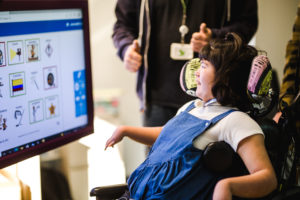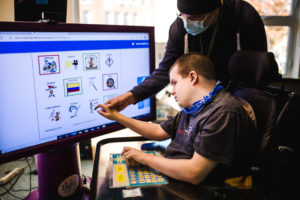Assistive Technology in the Classroom
Written by Colleen Gorman, Assistive Technology Specialist, Kennedy Day School at Franciscan Children’s
Advancements in technology have changed how our world functions. There are devices that can complete daily chores, like washing the dishes or vacuuming, and others that can gather information and bring it to you with just a click of a button. Technology has also strengthened how educators help students learn, especially those with cognitive or physical disabilities. Using assistive technology, students have access to resources that are adapted to their individual needs.
Assistive technology is defined as, “any item, piece of equipment, or product system…that is used to increase, maintain, or improve functional capabilities of individuals with disabilities” (Edutopia.org). This can range from low-tech equipment, like a pencil grip, to high-tech communication devices. At Kennedy Day School, we have a wide variety of assistive technology tools that empower students to learn and thrive at their own pace and ability level.
One piece of assistive technology that is frequently used in Kennedy Day School classrooms are SMART Boards. Each SMART Board is connected to the classroom’s desktop computer, allowing teachers to project their lessons to the screen. Students can interact with the SMART Board through physical touch or by using switch activation. SMART Boards are frequently used throughout the day because of their ability to support learning in students of all abilities.
For students with physical disabilities, each SMART Board has a touch-sensitive surface that allows students to participate in learning without the need to use excessive force to activate the screen. It also allows students who may not have fine motor skills to hold a pen with the ability to write and interact with content by using their fingers. For students who have trouble using traditional keyboards, the touch and click ease functionality allows them to easily interact with the teacher’s lesson. SMART Boards also give teachers the ability to present lessons in a more visual way and allow them to easily alter activities to meet the individual needs of each student.
Students with cognitive disabilities can also benefit from using SMART Boards. This technology allows students to complete lessons in a more interactive way, bringing each lesson to life. Teachers can display videos that help demonstrate the logic that led to a correct answer and to help focus attention to a process or sequence. This piece of assistive technology is a great tool in helping students to improve their communication skills through group participation.
Through the use of assistive technology in the classroom, Kennedy Day School students have access to a curriculum that is tailored to their individual learning needs.

 View All Blog Stories
View All Blog Stories